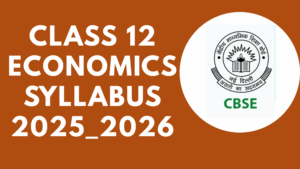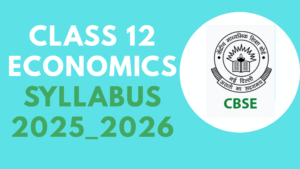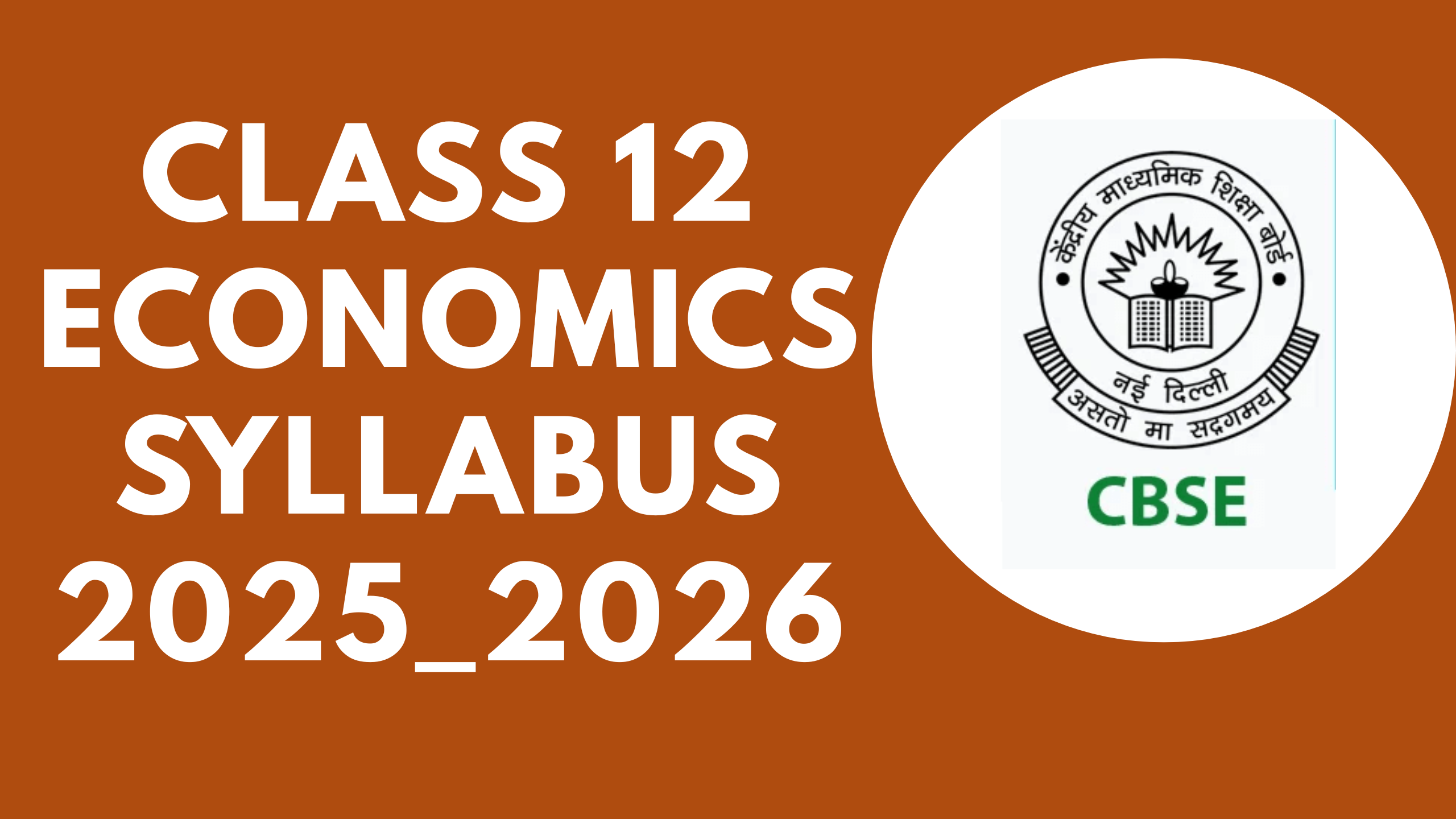Economics is one of the most important subjects for Class 12 students, especially for those aspiring to pursue careers in commerce, finance, management, or civil services. The subject not only builds a strong foundation for higher education but also enhances critical thinking and decision-making abilities in real-life economic scenarios.
The Class 12 Economics Syllabus 2025_2026 has been carefully designed by the CBSE (Central Board of Secondary Education) to provide students with a balance of theoretical concepts and practical applications. It is divided into two major parts—Part A: Introductory Macroeconomics and Part B: Indian Economic Development—along with a Project Work component.

This blog post provides a complete breakdown of the Class 12 Economics syllabus 2025_2026, including unit-wise topics, marks distribution, exam pattern, and preparation tips. Whether you are a student, teacher, or parent, this detailed guide will help you understand everything you need to know about the upcoming academic session.
Class 12 Economics Syllabus 2025_2026 | CBSE Unit-Wise Details, Exam Pattern & Marks Distribution
Overview of Class 12 Economics Syllabus 2025_2026
-
Board: CBSE (Central Board of Secondary Education)
-
Subject: Economics
-
Class: 12 (Senior Secondary)
-
Academic Session: 2025–2026
-
Total Marks: 100 (80 Marks Theory + 20 Marks Project Work)
-
Duration of Exam: 3 Hours
-
Major Parts:
-
Part A: Introductory Macroeconomics
-
Part B: Indian Economic Development
-
Project Work
-
Unit-Wise Class 12 Economics Syllabus 2025_2026

Part A: Introductory Macroeconomics (40 Marks)
Macroeconomics deals with the functioning of the economy as a whole. It covers national income, money and banking, government budget, and balance of payments.
Unit 1: National Income and Related Aggregates
-
Basic concepts: Consumption goods, capital goods, final goods, intermediate goods, stocks and flows, gross investment and depreciation.
-
Circular flow of income.
-
Methods of calculating national income: Value added method, income method, expenditure method.
-
Concepts of GDP, GNP, NDP, NNP (at market price and factor cost).
-
Real GDP vs Nominal GDP.
-
Limitations of GDP as a measure of welfare.
Unit 2: Money and Banking
-
Meaning and functions of money.
-
Evolution of money: Barter system to modern currency.
-
Central Bank (RBI): Functions, monetary policy, control of credit.
-
Commercial banks: Functions, process of money creation.
Unit 3: Determination of Income and Employment
-
Aggregate demand and its components.
-
Aggregate supply and related concepts.
-
Propensity to consume, propensity to save, investment multiplier.
-
Determination of equilibrium income and output.
-
Concept of full employment and involuntary unemployment.
Unit 4: Government Budget and the Economy
-
Government budget—meaning, objectives, and components.
-
Revenue and capital receipts, revenue and capital expenditure.
-
Fiscal deficit, revenue deficit, primary deficit.
-
Types of taxes: Direct and indirect.
-
Measures to control fiscal deficit.
Unit 5: Balance of Payments
-
Balance of payments—meaning and components.
-
Balance of trade vs balance of payments.
-
Foreign exchange rate—meaning, determination, and fluctuation.
-
Managed floating exchange rate system.
Part B: Indian Economic Development (40 Marks)
This section focuses on India’s economic policies, development, and challenges after independence.
Unit 6: Development Experience (1947–1990) and Economic Reforms Since 1991
-
Indian economy at the time of independence.
-
Goals of five-year plans.
-
Features, problems, and policies of agriculture, industry, and foreign trade (1947–1990).
-
Liberalisation, Privatisation, and Globalisation (LPG reforms of 1991).
-
Impact of economic reforms on various sectors.
Unit 7: Current Challenges Facing Indian Economy
-
Poverty: Causes, measures, and poverty alleviation programs.
-
Human Capital Formation: Role of education and health in economic development.
-
Rural Development: Rural credit, agricultural marketing, role of cooperatives and self-help groups.
-
Employment: Types, causes of unemployment, employment generation programs.
-
Infrastructure: Energy, health, and education infrastructure.
-
Sustainable Development: Concept, need, and strategies for sustainability.
Unit 8: Development Experience of India – A Comparison with Neighbours
-
Comparative study of India, China, and Pakistan.
-
Key indicators: GDP growth, population, human development indicators, employment structure.
-
Lessons India can learn from China and Pakistan.
Part C: Project Work (20 Marks)
Students are required to undertake one project on any economic topic related to the syllabus.
Suggested Topics:
-
Impact of government schemes on poverty reduction.
-
Comparative study of Indian and Chinese economies.
-
Trends in unemployment in India.
-
Role of RBI in monetary policy.
-
Inflation and its impact on daily life.
Assessment Criteria:
-
Introduction and objectives: 2 Marks
-
Content/data collection: 4 Marks
-
Presentation and analysis: 6 Marks
-
Conclusion: 4 Marks
-
Viva voce: 4 Marks
Marking Scheme for Class 12 Economics 2025_2026
| Part | Units | Marks |
|---|---|---|
| Part A: Introductory Macroeconomics | National Income, Money & Banking, Employment, Government Budget, Balance of Payments | 40 |
| Part B: Indian Economic Development | Development Experience, Current Challenges, Comparative Study | 40 |
| Project Work | One project report | 20 |
| Total | 100 |
Exam Pattern for Class 12 Economics 2025_2026
-
Type of Questions: Very short answer, short answer, long answer, and case-based questions.
-
Number of Sections: 2 (Macroeconomics and Indian Economic Development).
-
Time Allowed: 3 hours.
-
Internal Choices: Available in most sections.
-
Weightage of Questions:
-
Remembering & Understanding: 50%
-
Application: 30%
-
Higher-Order Thinking Skills (HOTS): 20%
-
Preparation Strategy for Class 12 Economics 2025_2026
-
Understand Concepts Clearly: Focus on definitions, formulas, and graphs.
-
Make Notes: Prepare short notes for each chapter for quick revision.
-
Practice Numerical Questions: National income, money creation, and government budget require practice.
-
Solve Previous Year Papers: Helps understand the exam pattern.
-
Focus on Case Studies: Since CBSE has introduced case-based questions, practice real-life applications.
-
Revise Regularly: Weekly revision ensures retention of concepts.
-
Stay Updated: Read newspapers and economic surveys to relate syllabus with current affairs.
FAQs
Class 12 Economics Syllabus 2025_2026

Q1. What is the total marks distribution for Class 12 Economics 2025_2026?
Ans: The exam carries 100 marks: 80 marks for theory and 20 marks for project work.
Q2. How many parts are there in the Class 12 Economics syllabus 2025_2026?
Ans: Two main parts—Introductory Macroeconomics and Indian Economic Development—along with project work.
Q3. Which topics are most important for Class 12 Economics board exam?
Ans: National Income, Money & Banking, Government Budget, Poverty, Employment, and Comparative Study with China and Pakistan are highly important.
Q4. Is project work compulsory in Class 12 Economics?
Ans: Yes, project work is compulsory and carries 20 marks.
Q5. Are there numerical problems in Class 12 Economics exam?
Ans: Yes, numerical questions are asked from topics like National Income, Money Creation, and Government Budget.
Q6. How to score full marks in Class 12 Economics?
Ans: Practice diagrams, use proper headings, give examples, and write precise answers.
Q7. Does CBSE change Class 12 Economics syllabus every year?
Ans: Minor changes may occur, but the core units generally remain the same.
Q8. What is the weightage of Macroeconomics in the exam?
Ans: Macroeconomics carries 40 marks in theory.
Q9. Is case study included in the syllabus?
Ans: Yes, case-based questions are part of the exam pattern.
Q10. Can I prepare for competitive exams like CUET or UPSC with Class 12 Economics?
Ans: Yes, the Class 12 Economics syllabus builds a strong foundation for CUET, UPSC, and other competitive exams.
Conclusion
The Class 12 Economics Syllabus 2025_2026 is designed to help students understand both theoretical concepts and their practical applications in the real world. With equal emphasis on Macroeconomics and Indian Economic Development, it equips learners with analytical skills to evaluate economic policies and issues.
By following the unit-wise syllabus, understanding the exam pattern, and preparing with dedication, students can score high in their board exams and also strengthen their foundation for higher studies. Remember, consistent revision, practice of numerical questions, and clarity of concepts are the keys to success in Economics.
